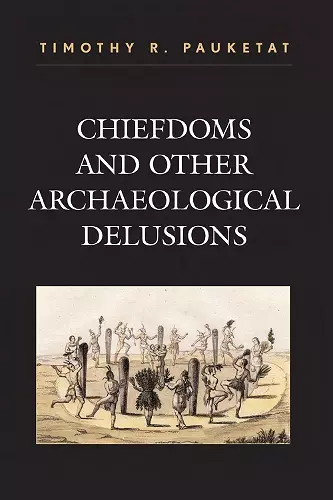Chiefdoms and Other Archaeological Delusions
Format:Paperback
Publisher:AltaMira Press
Published:25th May '07
Currently unavailable, and unfortunately no date known when it will be back

In recent decades anthropology, especially ethnography, has supplied the prevailing models of how human beings have constructed, and been constructed by, their social arrangements. In turn, archaeologists have all too often relied on these models to reconstruct the lives of ancient peoples. In lively, engaging, and informed prose, Timothy Pauketat debunks much of this social-evolutionary theorizing about human development, as he ponders the evidence of 'chiefdoms' left behind by the Mississippian culture of the American southern heartland. This book challenges all students of history and prehistory to reexamine the actual evidence that archaeology has made available, and to do so with an open mind.
Pauketat's bold thinking should move Mississippi Valley prehistory out from the shadows and onto archaeology's center stage, where it belongs–alongside the world's other civilizations, Old and New. Readers accustomed to wigwams,chiefs, and mound-builders are in for a shock. Native history in North America was far grander, far more interesting, than old textbooks allow. This book is really interesting! Pauketat is taking American archaeology in exciting new directions. -- Stephen H. Lekson, curator of archaeology, University of Colorado Museum of Natural History
A top flight synthesis of the development of complex societies in Eastern North America, from a theoretical perspective refreshingly different from the mainstream. A cross between Walter Taylor’s A Study of Archeology and Kent Flannery’s The Early Mesoamerican Village, Pauketat pulls no punches while humorously and incisively summarizing current research and thinking on the subject in the region and beyond, and in telling us how we can do better. Any archaeologist interested in North American archaeology or in the exploration of complex societies needs to read this book. Some of you are going to love it; some, I suspect, are going to hate it. But this volume provides, I believe, a good picture of how many scholars are going to be thinking about these subjects in the years to come. -- David G. Anderson, University of Tennessee; co-author (with Kenneth E. Sassaman) of Recent Developments in Southeastern Archaeology: From Colonization to Complexity
In Chiefdoms and Other Archaeological Delusions, Timothy Pauketat confronts his colleagues with the stereotypes that guide our interpretations of past societies. Do our ethnographic models serve archaeology well? Do they reflect the full range of societies in the past, or are archaeologists imitatively forcing great variety and creativity into a few shallow ideological niches? Are North American archaeologists taught to systematically diminish the accomplishments of Native North American societies? Wrapped around a deceptively simple question—“What was Cahokia?”—Pauketat’s sometimes colloquial, sometimes sharply incisive discussion challenges us to review our biases, cast off social-evolutionary shackles, and go boldly into a historically nuanced and broadly comparative American past. -- Kit Wesler, Murray State University
Chiefdoms and Other Archaeological Delusions is not your typical book about Mississippian archaeology; there is more theorizing, critique, and cross-cultural comparison. Then again Pauketat is not your typical Mississippian archaeologist. Borrowing a page from Flannery's Early Mesoamerican Village, Pauketat invents a cast of colorful characters to critically evaluate the problems and potential for the archaeology of complexity in the Southeastern United States. -- Gregory Wilson, Muhlenberg College
In this intriguing study of the prehistory of the eastern U.S. and how it compares to that of the Southwest, Oaxaca, and the Near East, Pauketat eschews the study of institutions and social evolution for the study of people and their interactions: Instead of looking to check off the attributes of institutions or organizations—were there palaces, royal tombs, writing?—we look instead for a series of relationships that played out historically. How were central places built, central orders memorialized, and producer autonomy sacrificed?" His is 'a backdoor approach to building a historical theory of civilization,' considering non-elite agency as well as activities of the elites. In all of the areas Pauketat examines, he sees migrations and the dislocations and opportunities they provide as critical in catapulting societies toward urbanism. This volume will repay rereading and careful study, and this reviewer intends to assign it in her North American prehistory course in the spring. Highly recommended. * Choice Reviews *
This book is a passionate polemic about several 'delusions' Pauketat believes lead archaeologists into serious theoretical and methodological errors. This is a very entertaining, creative, and irritating book. It would enliven a seminar class on complexity, archaeological theory, or North American archaeology. * Canadian Journal of Archaeology *
ISBN: 9780759108295
Dimensions: 231mm x 155mm x 14mm
Weight: 370g
270 pages